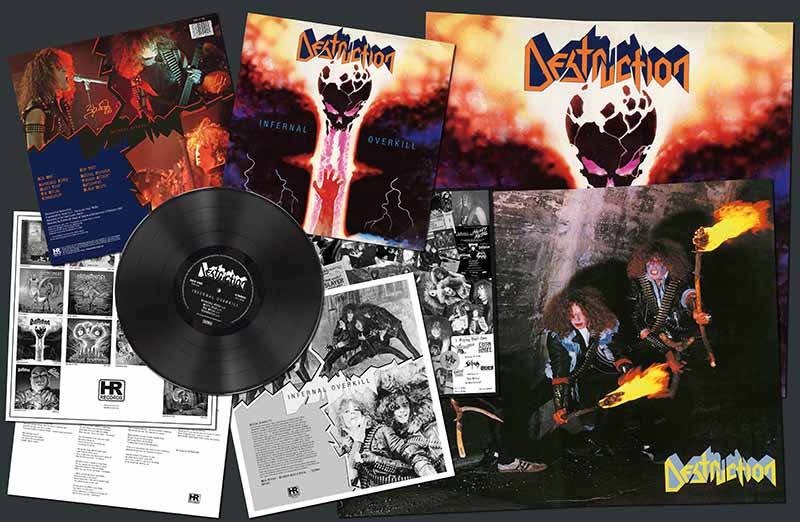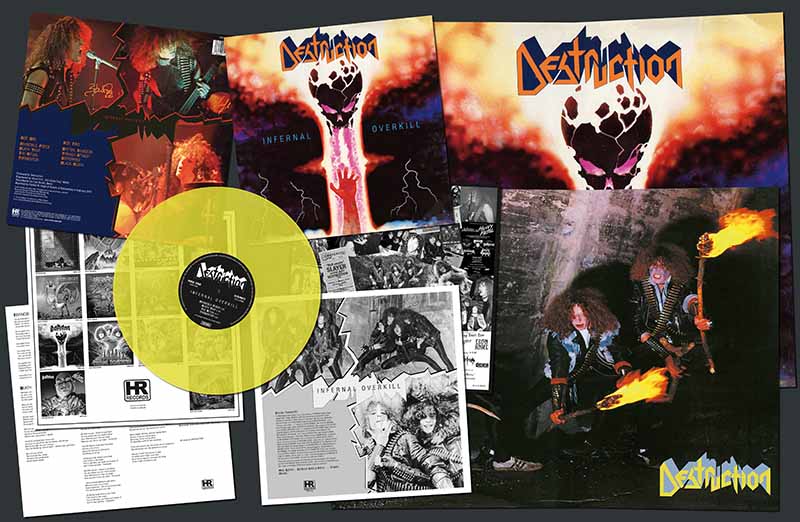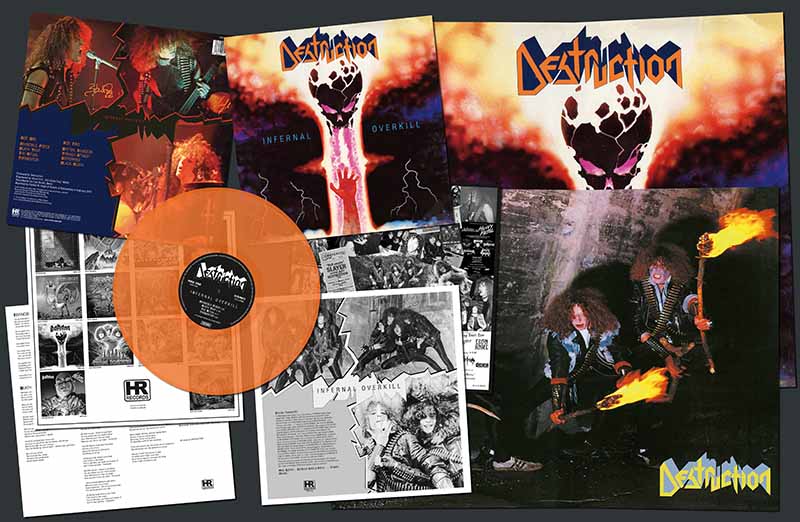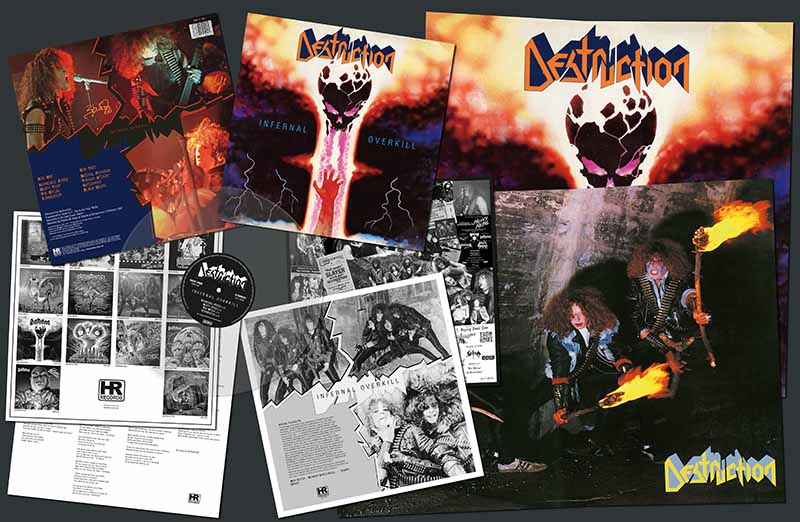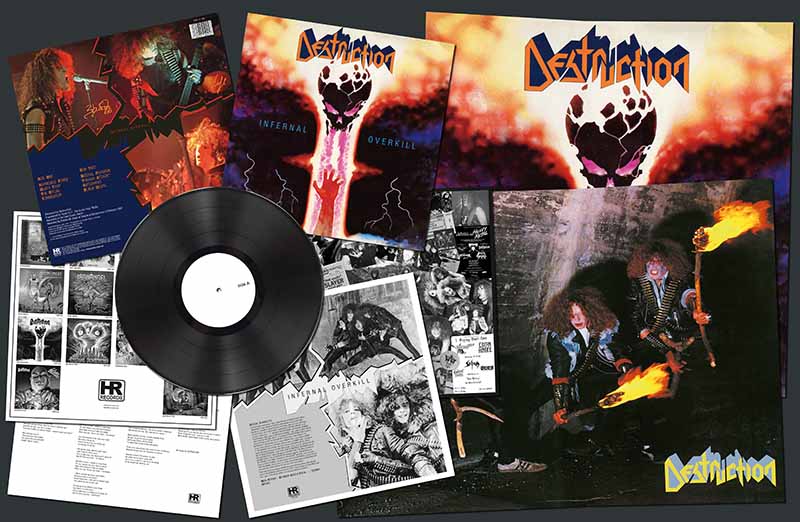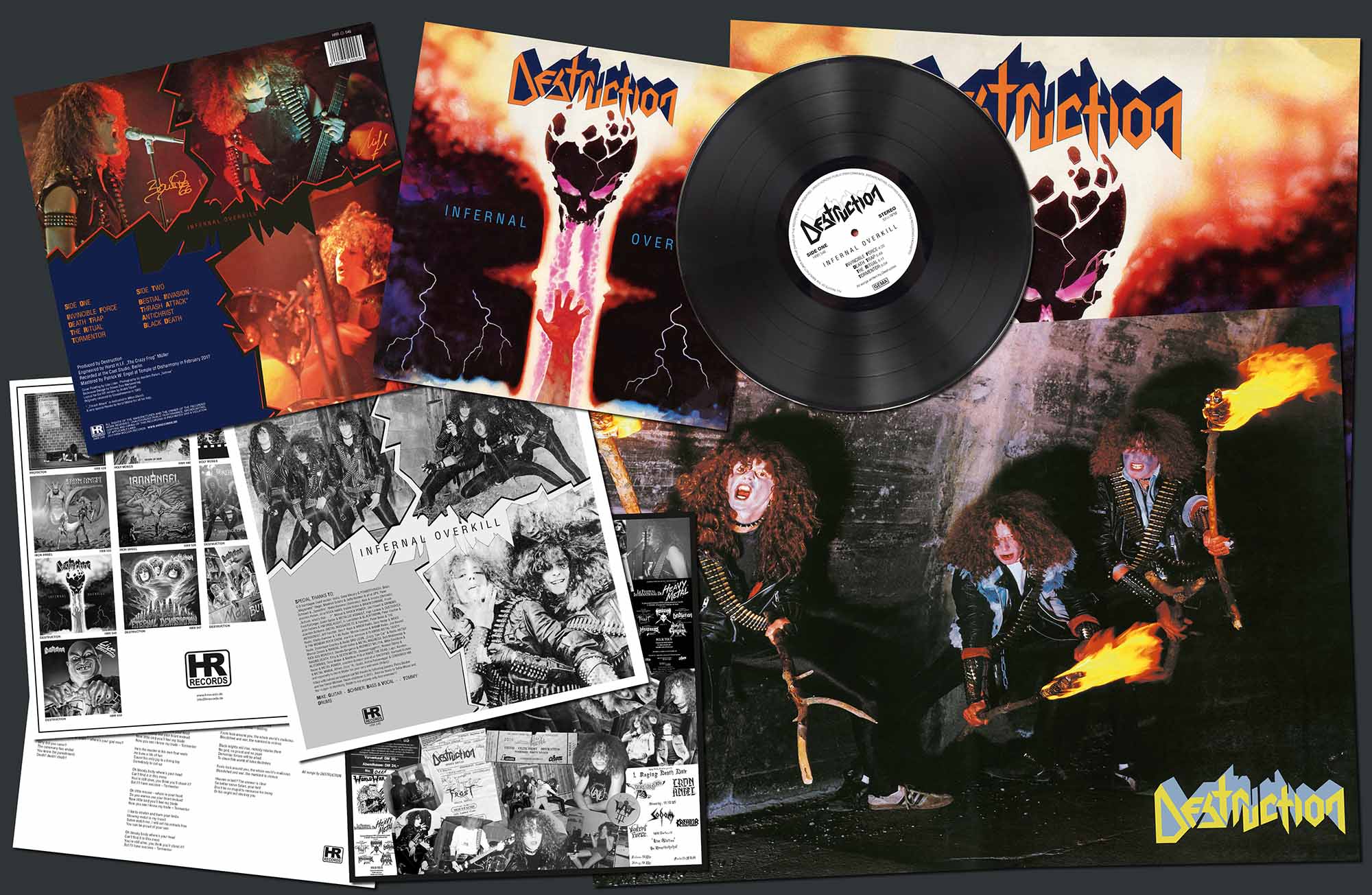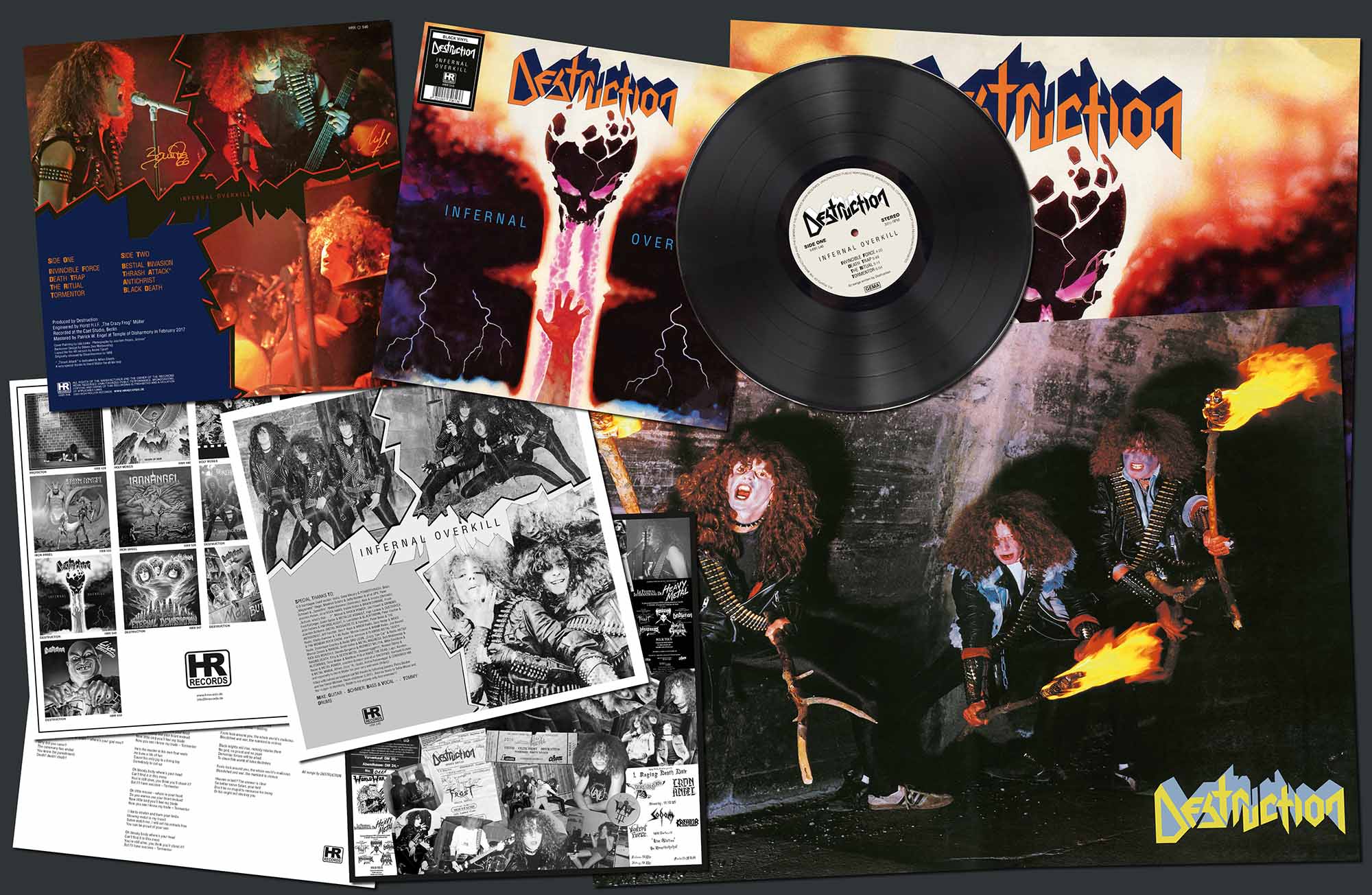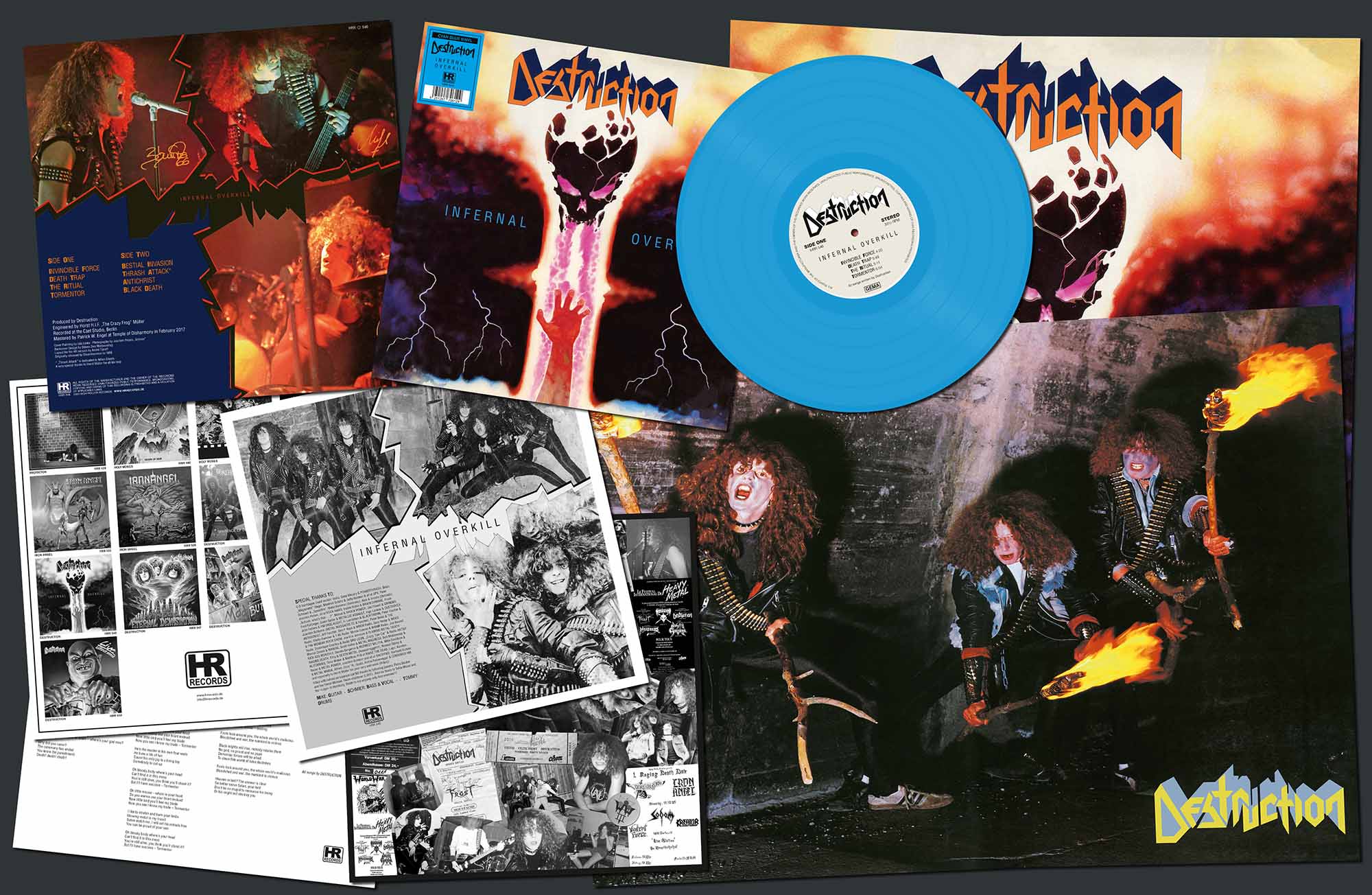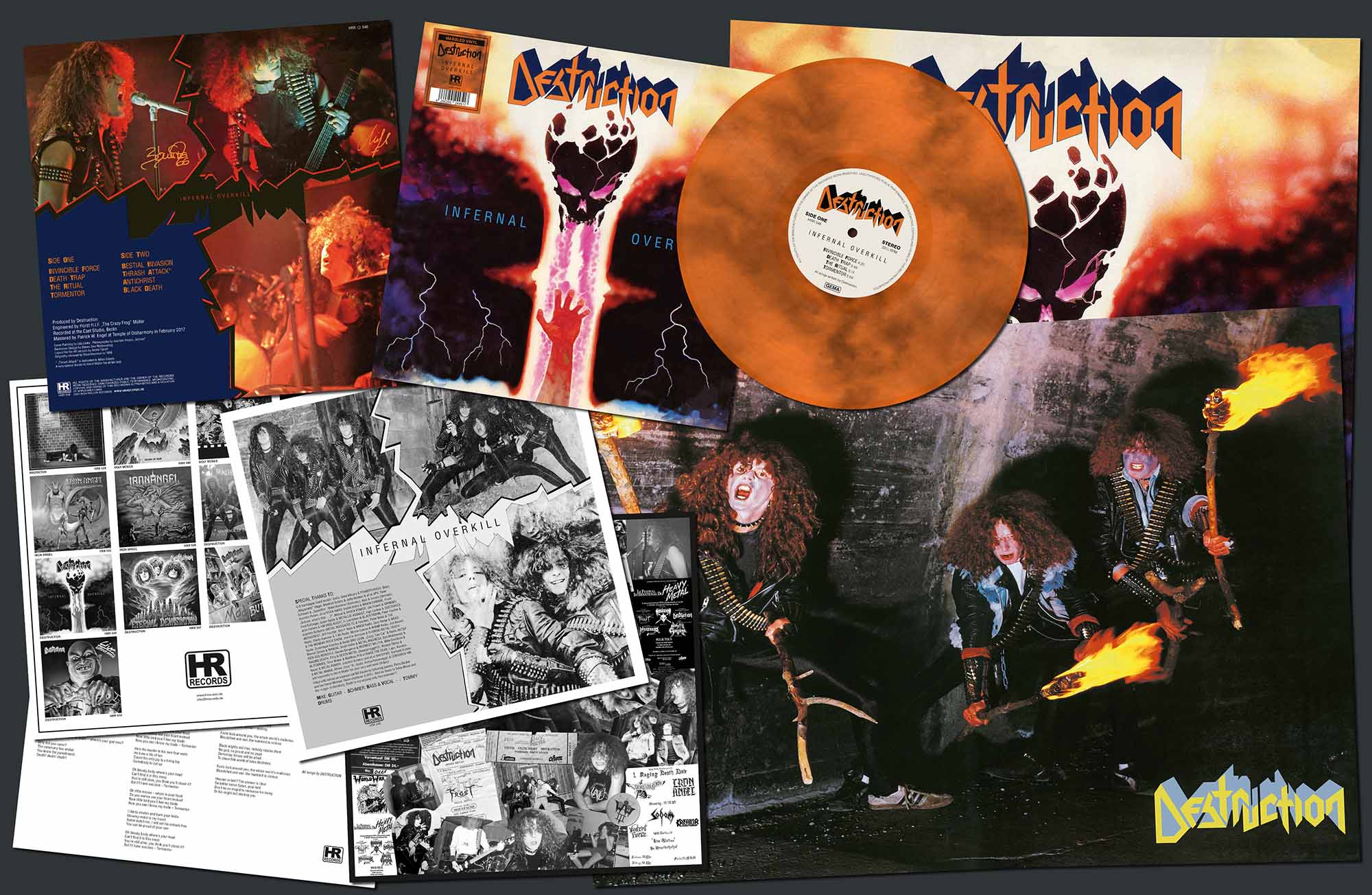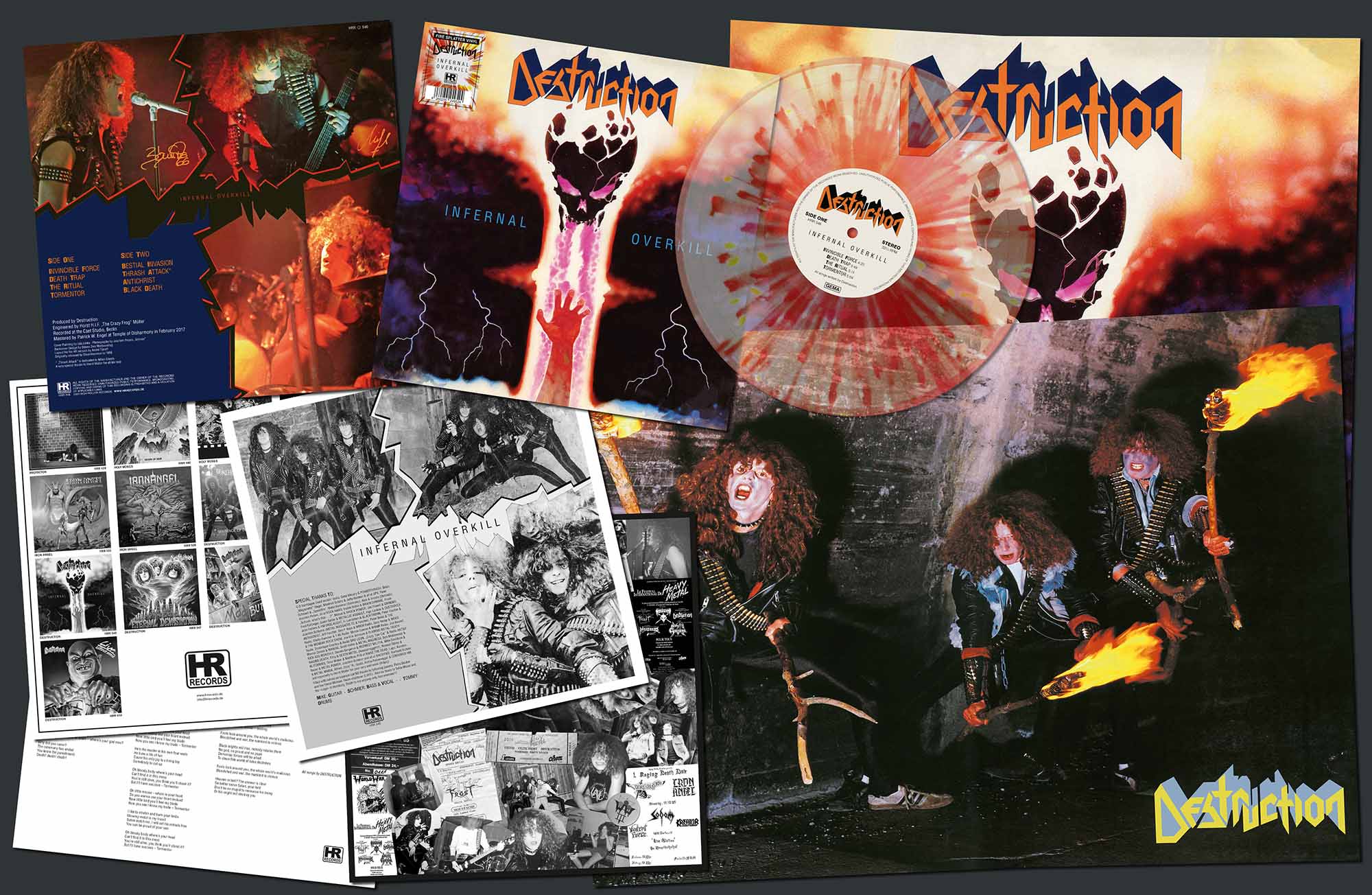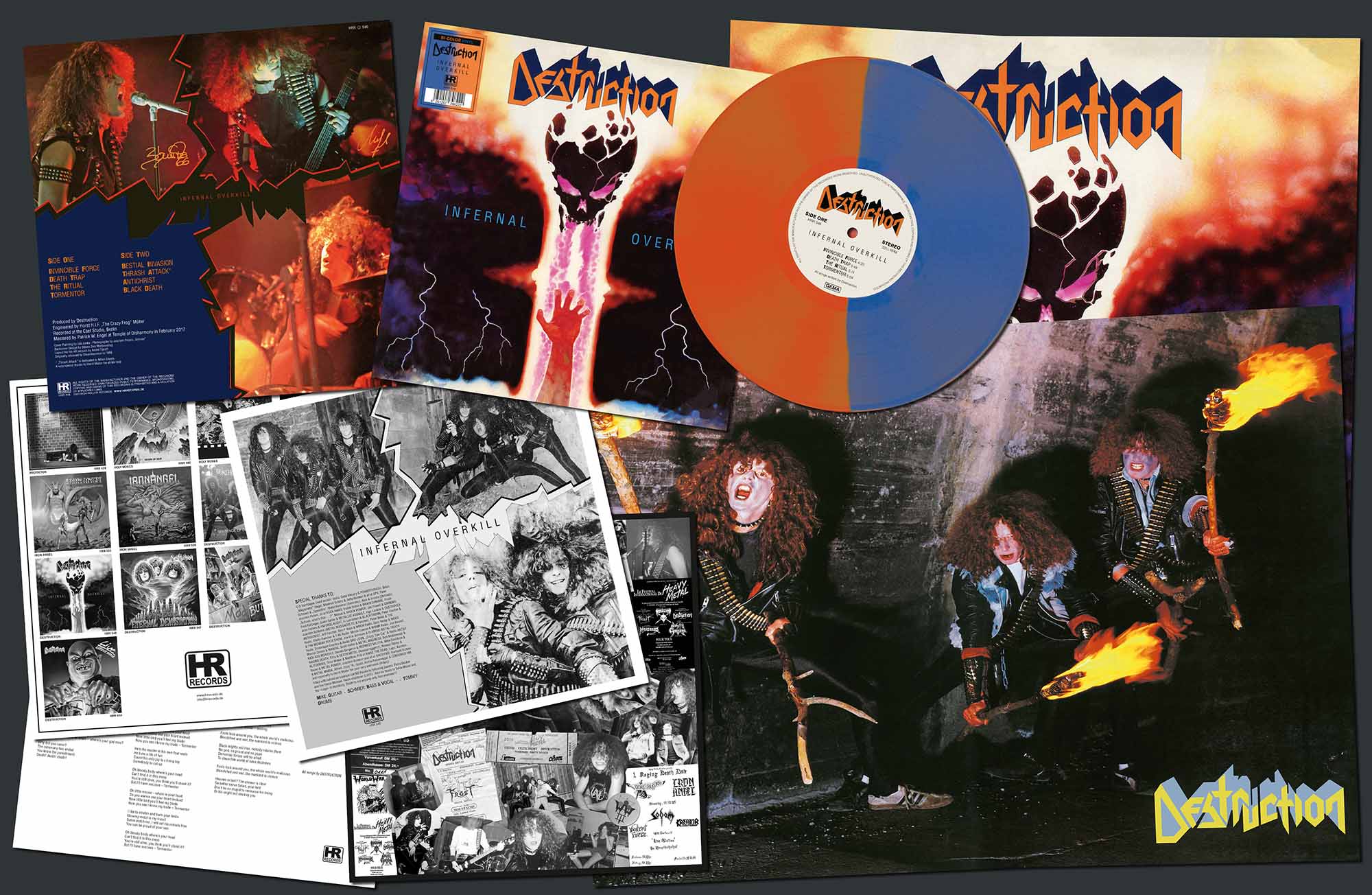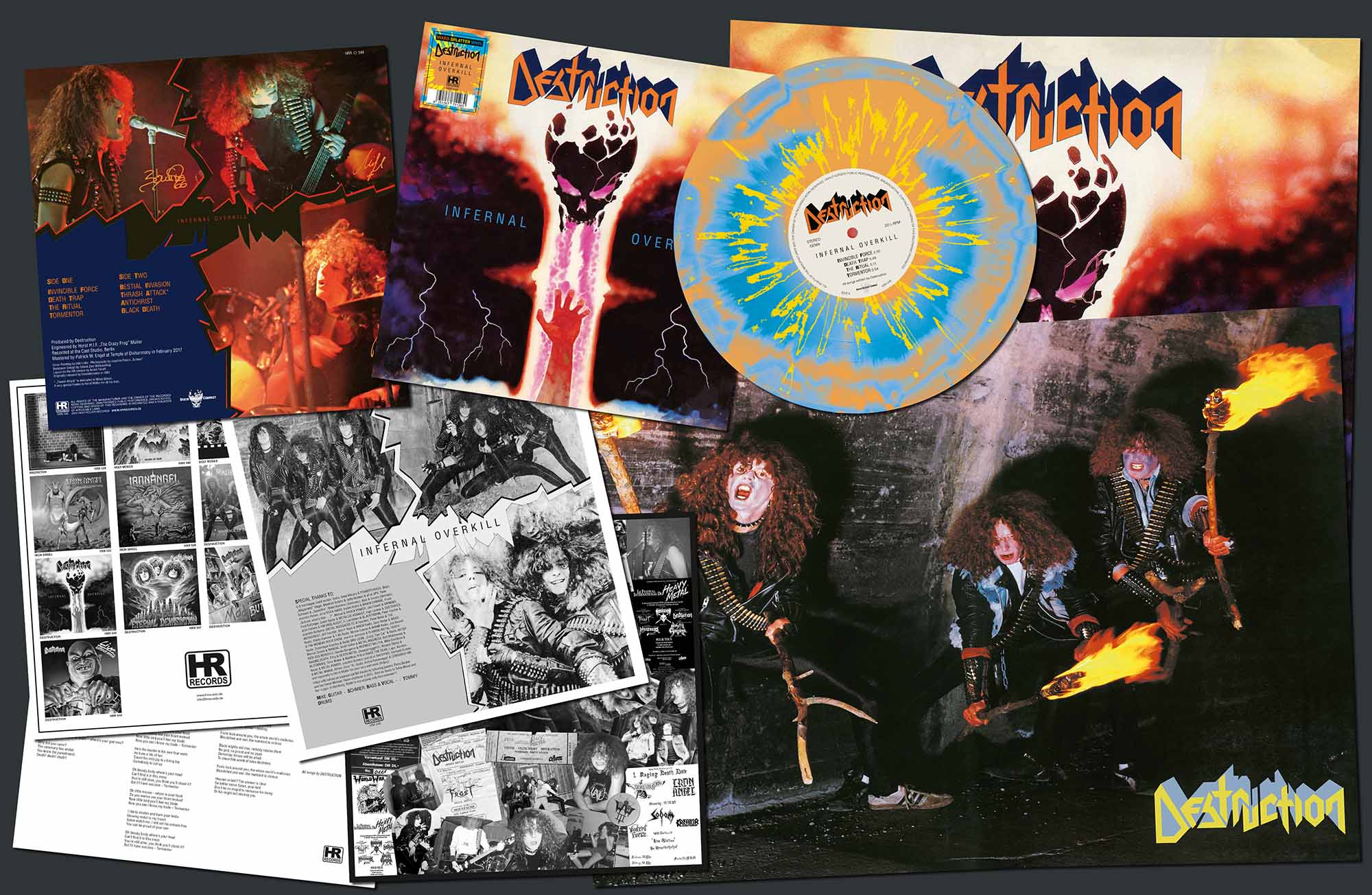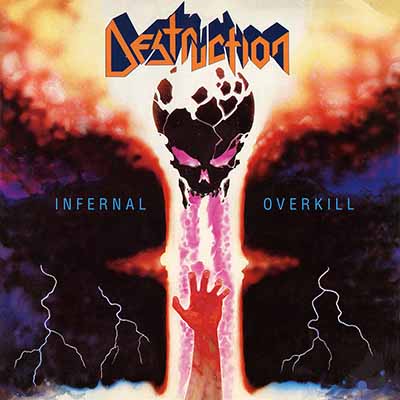 | ||||
| DESTRUCTION - Infernal Overkill LP | |
HRR 546, ltd 2000, 150 x transparent ultra clear (HRR mailorder exclusive), 750 x transparent piss yellow, 500 x transparent orange crush + 600 x black vinyl, 425gsm heavy cardboard cover, insert, printed inner sleeve, 2 poster, 2nd pressing: ltd 500, 250 x black + 250 x transparent electric blue vinyl, 3rd pressing: ltd 500, 250 x black + 250 x cyan blue vinyl, 4th pressing: ltd 500, 200 x transparent orange/ black marbled + 300 x transparent ultra clear with red & yellow "FIRE" splatter vinyl, 5th pressing: ltd 500, 200 x black + 300 x blue/ orange bi-color vinyl, 6th pressing: ltd 1000, 400 x black + 600 x oprange/ blue merged w/ yellow splatter vinyl, 7th pressing: ltd 750, 300 x black + 450 x gold vinyl, 8th pressing: 750 x 180g vinyl, 2 inserts, 2-sided poster | |
| Schmier - Bass, Vocals Mike Sifringer - Guitars Tommy Sandmann - Drums | |
| 1. Invincible Force 2. Death Trap 3. The Ritual 4. Tormentor 5. Bestial Invasion 6. Thrash Attack 7. Antichrist 8. Black Death | |
| 1st-6th pressing: SOLD OUT! 7th pressing: LAST COPIES 180g black vinyl: AVAILABLE | |
Mastered by Patrick W. Engel at TEMPLE OF DISHARMONY in February 2017. Original 1985 sound!
“Infernal Overkill”, the much loved debut album by German thrash metal legend Destruction was first released in 1985. Their EP “Sentence of Death” from the year before had paved the way for greater things, but Destruction still kept their feet on the ground, as Schmier remembers: “We all had day jobs and/or were still training for a job. So music was just a hobby. The reactions we got for 'Sentence of Death' was a big motivation, so we kept on writing songs and rehearsed a lot at that time. I even gave up my beloved football for it and left my team cause we wanted to get the band going.”
Compared to what they did on “Sentence of Death”, with “Infernal Overkill” Destruction had refined their style, trading most of the heavy metal influences for even more speed, heaviness and ferocity. That was a development Destruction had consciously worked for, as original drummer Tommy explains: “Yes, that was a consequent step in the development of the band. Some songs turned out more diversified than on 'Sentence of Death' – think of 'Black Death'. For a band playing that kind of music at that time, there were quiet a few tempo changes and pretty long songs.”
To record their debut LP, Destruction had once more travelled to Berlin, the then still divided hotspot of the Cold War. Schmier has the details about the recording process: “Yes indeed, we recorded in Berlin again, and again with Horst Müller at Caet Studio. This time, Horst knew us already so he wasn’t that shocked... haha! These recording sessions were longer and went much smoother than the first ones. More experience and a better organization and time frame helped a lot.”
Reviewers often praise how the album manages to be both catchy and inventive at the same time, especially when it comes to the riffing. How much of this was actually planned for, and how much of it simply came from an “instinct for good thrash”?
This time it's Mike who gives the answer: “There was no big plan behind it. We just tried to be as brutal as possible... If a song is too catchy, it sometimes becomes cheesy and flat. I always wanted to present my own riff ideas, so I made them fit into our concept.”
The debut features two songs from the demo, namely “Antichrist” and “Tormentor”. Schmier explains what had been changed about the album versions in comparison to the older recordings: “Basically the band had gotten a bit tighter and we changed the leads/solos. Mike’s solos on the demo were first takes, and now we had some time to work stuff out. That helped a lot. The same goes for the vocals, they have for sure improved compared to the demo version.”
Asked if he would like to change anything about how the album was recorded, if someone gave him a chance to do so, Tommy gives a quite decisive answer: “Well, not really, because you can feel the tension and the aggressiveness. The record is a pretty authentic mirror of the vibes of that time. The band stood fully behind it.”
Of course “Infernal Overkill” did provoke some reactions among fans and press, and Mike remembers that those reactions were “mainly very positive. But it wasn’t easy to get any information about how people liked the album, back in the day. There was no chance to get a hold of all these foreign mags and fanzines in Germany. We always had to wait for the record company to send us their collected reviews.” In his very positive review for the German Rock Hard magazine, Götz Kühnemund stated that 'for Black Metal standards, their musical skills and abilities are quite high'. Is it this what sets Black Metal and Thrash Metal apart, the level of musical technique and proficiency? Schmier does not have a simple answer to this one: “At that time, there were no fixed labels and not so much stereotyped thinking when it came to music. We called ourselves Black-Speed-Hardcore Metal back then. I think extreme European bands did not have as high musical standards as American ones, I guess that’s what Götz may have been referring to. Our guitarist Mike was ahead of time at this period, that’s for sure.”
The release of “Infernal Overkill” was followed by a tour with Slayer, “which completely changed our lives…” as Schmier says meaningfully. And shortly after that, Destruction even played the World War III festival in Montreal with Nasty Savage, Possessed, Celtic Frost and Voivod in Montreal, Canada. Tommy shares a special memory from that event: “This one is not my favorite memory, but it’s the one which is still very present: The night before the concert, we went out to party with some local dudes. At some point I got separated from the rest of the guys and got lost in the city. We got into Montreal on that same day, so I had no memory of what hotel we were in or where it was located. It was November, it was cold and I strayed around Montreal all night and finally at dawn I found the hotel, freezing and tired, but meanwhile sober. There was just enough time to catch some sleep to get fit for the show, and Schmier and Mike were happy about the return of the prodigal son…” That's for sure, because if he had gone lost forever, the history of Destruction would not have been the same. But let's get back to the album and talk about it in more detail. Schmier explains what he likes best about it and if there is one single song that defines the album and sticks out among the lot, or if he prefers to look at the album as a whole: “'Bestial Invasion' with its distinguished riff is surely a fan favorite, but to me the album as a whole has a great spirit and lots of aggression. In our live set, 'Infernal' songs still have a special meaning, 'cause the kids love those songs deep from their black hearts.”
Infernal Overkill was the first release to sport the legendary logo. Mike relates the story behind it: “One fine day a guy from the States sent me a sketch, presenting an idea for a new band logo. I liked it, but it was a little uneven and messy. So I refined it and added the 3D-perspective.” And Schmier has something very important to add about “Infernal Overkill” and the changes it brought about: “'Infernal Overkill' also marks the first appearance of the infamous skull – we did not know at that time that both things, logo and skull, would merge into such a big trademark even 32 years later! Alongside 'The Antichrist', 'Infernal Overkill' is still our most successful album up to this date.”
Ulrike Schmitz
